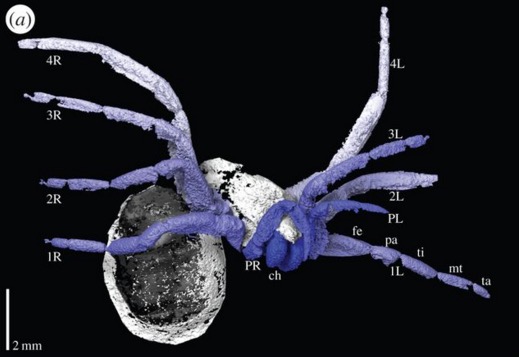If digging up long-dead animals doesn’t exactly sound exciting to you, consider that we’re still missing relatively large pieces of some evolutionary puzzles, and finding them could increase our understanding of life as we know it. … Or it could bring us creepy-looking “almost spiders.” That’s also a possibility, as we now know.
The almost spider in question is a newfound fossil preserved in rock from the same period as the oldest known spider ancestor fossil: about 305 million years ago. (We take solace in the idea that dinosaurs probably once terrorized spiders as much as spiders terrorize us.) That fossil was difficult to examine due to being encapsulated by rock, but new techniques have allowed scientists to analyze the contents of these rocks in greater detail and come up with the monster imagery you see above, detailed in a paper published in Proceedings of the Royal Society B.
However, unlike a lot of prehistoric animals, this one wasn’t actually as large and monstrous as it appears in the image. It’s only about 0.4 inches in reality, so you probably wouldn’t even notice a live one if it were around today, especially since it’d have no web for you to accidentally walk through and then spend about half an hour feeling like you hadn’t fully gotten it off of you yet.
That’s because the major evolutionary difference between these fossil specimens and modern spiders is that they don’t have the spinnerets that create the web. That, along with a segmented abdomen, is really all that separates the fossils from our modern wall-crawlers, which makes them a previously unknown bridge in the evolution of arachnids. Time travelers now know exactly the time to show up to prevent this whole spider thing from happening, give or take. Just saying.
(via LiveScience, image via Garwood et al 2016/Museum National d’Histoire Naturelle, Paris)
—The Mary Sue has a strict comment policy that forbids, but is not limited to, personal insults toward anyone, hate speech, and trolling.—
Follow The Mary Sue on Twitter, Facebook, Tumblr, Pinterest, & Google+.









Published: Mar 30, 2016 10:01 am